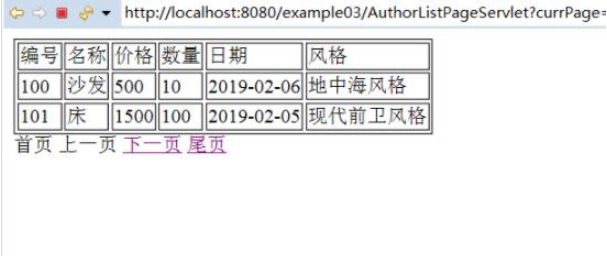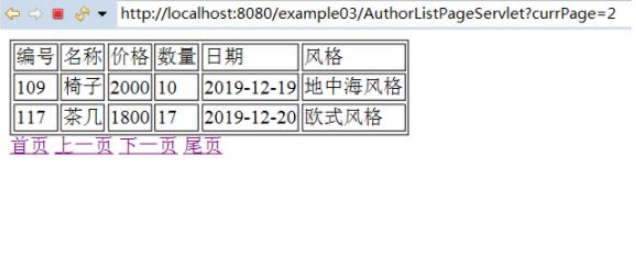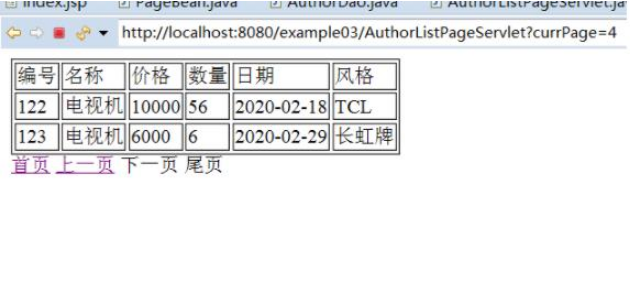 base de données
base de données
 tutoriel mysql
tutoriel mysql
 Comment utiliser jsp+mysql pour implémenter une requête de pagination sur des pages Web
Comment utiliser jsp+mysql pour implémenter une requête de pagination sur des pages Web
Comment utiliser jsp+mysql pour implémenter une requête de pagination sur des pages Web
1. L'instruction SQL de base pour implémenter la requête de pagination
(1) L'instruction SQL pour interroger le nombre total d'enregistrements dans la base de données :
select count(*) from +(表名);
(2 ) Les enregistrements de chaque requête Nombre d'instructions sql :
où : 0 est l'index de recherche, 2 est le nombre d'éléments recherchés à chaque fois.
select * from 表名 limit 0,2;
2. Implémentation du code
Dans l'article précédent, j'ai présenté la classe DBconnection et la classe d'objet Author. La première est utilisée pour obtenir la connexion à la base de données, et la classe d'objet Author. ce dernier est utilisé pour représenter l’objet Auteur. Cliquez sur le lien pour afficher le code de ces deux classes. Cliquez sur le lien pour afficher la classe DBconnection et la classe d'objet Author
(1) Page de connexion : index.jsp.
<%@ page language="java" contentType="text/html; charset=utf-8"
pageEncoding="utf-8"%>
<!DOCTYPE html>
<html>
<head>
<meta charset="utf-8">
<title>Insert title here</title>
</head>
<body>
<a href="AuthorListPageServlet">用户列表分页查询</a>
</body>
</html>(2) Afficher la page : userlistpage.jsp.
<%@ page language="java" contentType="text/html; charset=utf-8"
pageEncoding="utf-8"%>
<%@ taglib prefix="c" uri="http://java.sun.com/jsp/jstl/core" %>
<!DOCTYPE html>
<html>
<head>
<meta charset="utf-8">
<title>查询页面</title>
</head>
<body>
<table border="1">
<tr>
<td>编号</td>
<td>名称</td>
<td>价格</td>
<td>数量</td>
<td>日期</td>
<td>风格</td>
</tr>
<c:forEach items="${pageBean.list}" var="author">
<tr>
<td>${author.id}</td>
<td>${author.name }</td>
<td>${author.price }</td>
<td>${author.num }</td>
<td>${author.dates}</td>
<td>${author.style}</td>
</tr>
</c:forEach>
</table>
<c:if test="${ pageBean.record>0}">
<div>
<c:if test="${pageBean.currentPage <= 1}">
<span>首页</span>
<span>上一页</span>
<a href ="AuthorListPageServlet?currPage=${pageBean.currentPage + 1 }">下一页</a>
<a href ="AuthorListPageServlet?currPage=${pageBean.totalPage }">尾页</a>
</c:if>
<c:if test="${pageBean.currentPage > 1 && pageBean.currentPage < pageBean.totalPage }">
<a href ="AuthorListPageServlet?currPage=1">首页</a>
<a href ="AuthorListPageServlet?currPage=${pageBean.currentPage - 1 }">上一页</a>
<a href ="AuthorListPageServlet?currPage=${pageBean.currentPage + 1 }">下一页</a>
<a href ="AuthorListPageServlet?currPage=${pageBean.totalPage }">尾页</a>
</c:if>
<c:if test="${ pageBean.currentPage >= pageBean.totalPage}">
<a href ="AuthorListPageServlet?currPage=1">首页</a>
<a href ="AuthorListPageServlet?currPage=${pageBean.currentPage - 1 }">上一页</a>
<span>下一页</span>
<span>尾页</span>
</c:if>
</div>
</c:if>
</body>
</html>(3) Implémentation de la fonction : AuthorDao.java.
package com.dao;
import java.sql.Connection;
import java.sql.PreparedStatement;
import java.sql.ResultSet;
import java.sql.SQLException;
import java.util.ArrayList;
import java.util.List;
import com.entity.Author;
public class AuthorDao {
public Author check(String username ,int password ) {
Author obj = null ;
try {
DBConnection db = new DBConnection();
//获取数据库连接
Connection conn = db.getConn();
String sql="select *from furnitures where name = ? and id = ?";
PreparedStatement ps=conn.prepareStatement(sql);
//设置用户名和密码作为参数放入sql语句
ps.setString(1,username);
ps.setInt(2,password);
//执行查询语句
ResultSet rs = ps.executeQuery();
//用户名和密码正确,查到数据 欧式风格 茶几
if(rs.next()) {
obj = new Author();
obj.setId(rs.getInt(1));
obj.setName(rs.getString(2));
obj.setPrice(rs.getInt(3));
obj.setNum(rs.getInt(4));
obj.setDates(rs.getString(5));
obj.setStyle(rs.getString(6));
}
} catch (SQLException e) {
// TODO Auto-generated catch block
e.printStackTrace();
}
return obj;
}
/**
* 用户列表信息查询
* @return
*/
public List<Author> queryAuthorList(){
Author obj = null ;
List<Author> list = new ArrayList<Author>();
try {
DBConnection db = new DBConnection();
//获取数据库连接
Connection conn = db.getConn();
String sql="select *from furnitures";
PreparedStatement ps=conn.prepareStatement(sql);
//执行查询语句
ResultSet rs = ps.executeQuery();
//用户名和密码正确,查到数据 欧式风格 茶几
//循环遍历获取用户信息
while(rs.next()) {
obj = new Author();
obj.setId(rs.getInt(1));
obj.setName(rs.getString(2));
obj.setPrice(rs.getInt(3));
obj.setNum(rs.getInt(4));
obj.setDates(rs.getString(5));
obj.setStyle(rs.getString(6));
//将对象加入list里边
list.add(obj);
}
} catch (SQLException e) {
// TODO Auto-generated catch block
e.printStackTrace();
}
return list;
}
/**
* 查询用户表总记录数
* @return
*/
public int queryUserListCount() {
DBConnection db;
try {
db = new DBConnection();
Connection conn = db.getConn();
String sql = "select count(*) from furnitures";
PreparedStatement ps = conn.prepareStatement(sql);
ResultSet rs = ps.executeQuery();
if(rs.next()) {
return rs.getInt(1);
}
} catch (SQLException e) {
// TODO Auto-generated catch block
e.printStackTrace();
}
return 0;
}
/**
* 查询用户分页数据
* @param pageIndex数据起始索引
* @param pageSize每页显示条数
* @return
*/
public List<Author>queryUserListPage(int pageIndex,int pageSize){
Author obj = null;
List<Author> list = new ArrayList<Author>();
try {
Connection conn = new DBConnection().getConn();
String sql = "select * from furnitures limit ?,?;";
PreparedStatement ps = conn.prepareStatement(sql);
ps.setObject(1, pageIndex);
ps.setObject(2,pageSize);
ResultSet rs = ps.executeQuery();
//遍历结果集获取用户列表数据
while(rs.next()) {
obj = new Author();
obj.setId(rs.getInt(1));
obj.setName(rs.getString(2));
obj.setPrice(rs.getInt(3));
obj.setNum(rs.getInt(4));
obj.setDates(rs.getString(5));
obj.setStyle(rs.getString(6));
list.add(obj);
}
} catch (SQLException e) {
// TODO Auto-generated catch block
e.printStackTrace();
}
return list;
}
/**
* 用户新增
* @param obj
*/
public void add(Author obj) {
try {
DBConnection db = new DBConnection();
//获取数据库连接
Connection conn = db.getConn();
String sql="insert into furnitures values(id,?,?,?,?,?)";
PreparedStatement ps=conn.prepareStatement(sql);
ps.setObject(1, obj.getName());
ps.setObject(2, obj.getPrice());
ps.setObject(3, obj.getNum());
ps.setObject(4,obj.getDates());
ps.setObject(5, obj.getStyle());
//执行sql语句
ps.execute();
} catch (SQLException e) {
// TODO Auto-generated catch block
e.printStackTrace();
}
}
//删除用户
public void del(int id) {
try {
DBConnection db = new DBConnection();
//获取数据库连接
Connection conn = db.getConn();
String sql="delete from furnitures where id = ?";
PreparedStatement ps=conn.prepareStatement(sql);
ps.setObject(1, id);
//执行sql语句
ps.execute();
} catch (SQLException e) {
// TODO Auto-generated catch block
e.printStackTrace();
}
}
}(4) Couche d'interaction : AuthorListPageServlet.java.
package com.servlet;
import java.io.IOException;
import java.util.List;
import javax.servlet.ServletException;
import javax.servlet.annotation.WebServlet;
import javax.servlet.http.HttpServlet;
import javax.servlet.http.HttpServletRequest;
import javax.servlet.http.HttpServletResponse;
import com.dao.AuthorDao;
import com.entity.Author;
import com.util.PageBean;
/**
* Servlet implementation class AuthorListPageServlet
*/
@WebServlet("/AuthorListPageServlet")
public class AuthorListPageServlet extends HttpServlet {
private static final long serialVersionUID = 1L;
/**
* @see HttpServlet#HttpServlet()
*/
public AuthorListPageServlet() {
super();
// TODO Auto-generated constructor stub
}
/**
* @see HttpServlet#doGet(HttpServletRequest request, HttpServletResponse response)
*/
protected void doGet(HttpServletRequest request, HttpServletResponse response) throws ServletException, IOException {
// TODO Auto-generated method stub
int pageSize = 2;
AuthorDao ad = new AuthorDao();
//总记录数
int record = ad.queryUserListCount();
//接收页面传入的页码
String strPage = request.getParameter("currPage");
int currPage = 1;//默认第一页
if(strPage != null) {
currPage = Integer.parseInt(strPage);
}
PageBean<Author> pb = new PageBean<Author>(currPage,pageSize,record);
//查询某一页的结果集
List<Author> list = ad.queryUserListPage(pb.getPageIndex(), pageSize);
pb.setList(list);
request.setAttribute("pageBean", pb);
request.getRequestDispatcher("userlistpage.jsp").forward(request, response);
}
/**
* @see HttpServlet#doPost(HttpServletRequest request, HttpServletResponse response)
*/
protected void doPost(HttpServletRequest request, HttpServletResponse response) throws ServletException, IOException {
// TODO Auto-generated method stub
doGet(request, response);
}
}(5) Classe d'outils : PageBean.java. La fonction est la suivante : obtenir l'ensemble de résultats.
package com.util;
import java.util.List;
public class PageBean<T>{
private int currentPage;//当前页码
private int pageIndex;//数据起始索引
private int pageSize;//每页条数
private int record;//总记录数
private int totalPage;//总页数
private List<T>list;//每页显示的结果集
/**
* 构造方法初始化pageIndex和totalPage
* @param currentPage
* @param pageIndex
* @param pageSize
*/
public PageBean(int currentPage,int pageSize,int record) {
this.currentPage = currentPage;
this.pageSize = pageSize;
this.record = record;
//总页数
if(record % pageSize == 0) {
//整除,没有多余的页
this.totalPage = record / pageSize;
}
else {
//有多余的数据,在增加一页
this.totalPage = record / pageSize + 1;
}
//计算数据起始索引pageIndex
if(currentPage < 1) {
this.currentPage = 1;
}
else if(currentPage > this.totalPage) {
this.currentPage = this.totalPage;
}
this.pageIndex = (this.currentPage -1)*this.pageSize;
}
public int getCurrentPage() {
return currentPage;
}
public void setCurrentPage(int currentPage) {
this.currentPage = currentPage;
}
public int getPageIndex() {
return pageIndex;
}
public void setPageIndex(int pageIndex) {
this.pageIndex = pageIndex;
}
public int getPageSize() {
return pageSize;
}
public void setPageSize(int pageSize) {
this.pageSize = pageSize;
}
public int getRecord() {
return record;
}
public void setRecord(int record) {
this.record = record;
}
public int getTotalPage() {
return totalPage;
}
public void setTotalPage(int totalPage) {
this.totalPage = totalPage;
}
public List<T> getList() {
return list;
}
public void setList(List<T> list) {
this.list = list;
}
}3. Résultats en cours
(1) Page d'accueil :

(2) Page du milieu :

(3) Dernière page :

Ce qui précède est le contenu détaillé de. pour plus d'informations, suivez d'autres articles connexes sur le site Web de PHP en chinois!

Outils d'IA chauds

Undress AI Tool
Images de déshabillage gratuites

Undresser.AI Undress
Application basée sur l'IA pour créer des photos de nu réalistes

AI Clothes Remover
Outil d'IA en ligne pour supprimer les vêtements des photos.

Clothoff.io
Dissolvant de vêtements AI

Video Face Swap
Échangez les visages dans n'importe quelle vidéo sans effort grâce à notre outil d'échange de visage AI entièrement gratuit !

Article chaud

Outils chauds

Bloc-notes++7.3.1
Éditeur de code facile à utiliser et gratuit

SublimeText3 version chinoise
Version chinoise, très simple à utiliser

Envoyer Studio 13.0.1
Puissant environnement de développement intégré PHP

Dreamweaver CS6
Outils de développement Web visuel

SublimeText3 version Mac
Logiciel d'édition de code au niveau de Dieu (SublimeText3)

Sujets chauds
 Implémentation de transactions et compréhension des propriétés acides dans MySQL
Jul 08, 2025 am 02:50 AM
Implémentation de transactions et compréhension des propriétés acides dans MySQL
Jul 08, 2025 am 02:50 AM
MySQL prend en charge le traitement des transactions et utilise le moteur de stockage InNODB pour garantir la cohérence et l'intégrité des données. 1. Les transactions sont un ensemble d'opérations SQL, soit tous réussissent ou ne parviennent pas à reculer; 2. Les attributs acides comprennent l'atomicité, la cohérence, l'isolement et la persistance; 3. Les déclarations qui contrôlent manuellement les transactions sont StartTransaction, Commit and Rollback; 4. Les quatre niveaux d'isolement incluent la lecture non engagée, la lecture soumise, la lecture reproductible et la sérialisation; 5. Utilisez correctement les transactions pour éviter le fonctionnement à long terme, désactiver les validations automatiques et gérer raisonnablement les verrous et les exceptions. Grâce à ces mécanismes, MySQL peut obtenir une forte fiabilité et un contrôle simultané.
 Gestion des ensembles de personnages et des problèmes de collations dans MySQL
Jul 08, 2025 am 02:51 AM
Gestion des ensembles de personnages et des problèmes de collations dans MySQL
Jul 08, 2025 am 02:51 AM
Les problèmes de règles de jeu de caractères et de tri sont courants lors de la migration multiplateforme ou du développement multi-personnes, entraînant un code brouillé ou une requête incohérente. Il existe trois solutions principales: d'abord, vérifiez et unifiez le jeu de caractères de la base de données, de la table et des champs vers UTF8MB4, affichez via ShowCreateDatabase / Table, et modifiez-le avec une instruction alter; Deuxièmement, spécifiez le jeu de caractères UTF8MB4 lorsque le client se connecte et le définissez dans les paramètres de connexion ou exécutez SetNames; Troisièmement, sélectionnez les règles de tri raisonnablement et recommandez d'utiliser UTF8MB4_UNICODE_CI pour assurer la précision de la comparaison et du tri, et spécifiez ou modifiez-la via ALTER lors de la construction de la bibliothèque et du tableau.
 Connexion à la base de données MySQL à l'aide du client de ligne de commande
Jul 07, 2025 am 01:50 AM
Connexion à la base de données MySQL à l'aide du client de ligne de commande
Jul 07, 2025 am 01:50 AM
La façon la plus directe de se connecter à la base de données MySQL consiste à utiliser le client de la ligne de commande. Entrez d'abord le nom d'utilisateur MySQL-U -P et entrez correctement le mot de passe pour entrer l'interface interactive; Si vous vous connectez à la base de données distante, vous devez ajouter le paramètre -H pour spécifier l'adresse hôte. Deuxièmement, vous pouvez directement passer à une base de données spécifique ou exécuter des fichiers SQL lors de la connexion, tels que le nom de la base de données MySQL-U Username-P ou le nom de la base de données MySQL-U Username-P-P
 Gérer les jeux de caractères et les collations dans MySQL
Jul 07, 2025 am 01:41 AM
Gérer les jeux de caractères et les collations dans MySQL
Jul 07, 2025 am 01:41 AM
Le réglage des jeux de caractères et des règles de collation dans MySQL est crucial, affectant le stockage des données, l'efficacité de la requête et la cohérence. Premièrement, le jeu de caractères détermine la gamme de caractères storable, telle que UTF8MB4 prend en charge les chinois et les emojis; Les règles de tri contrôlent la méthode de comparaison des caractères, telle que UTF8MB4_UNICODE_CI est sensible à la casse, et UTF8MB4_BIN est une comparaison binaire. Deuxièmement, le jeu de caractères peut être défini à plusieurs niveaux de serveur, de base de données, de table et de colonne. Il est recommandé d'utiliser UTF8MB4 et UTF8MB4_UNICODE_CI de manière unifiée pour éviter les conflits. En outre, le problème du code brouillé est souvent causé par des jeux de caractères incohérents de connexions, de stockage ou de terminaux de programme, et doit être vérifié par calque par calque et définir uniformément. De plus, les ensembles de caractères doivent être spécifiés lors de l'exportation et de l'importation pour éviter les erreurs de conversion
 Concevoir une stratégie de sauvegarde de la base de données MySQL robuste
Jul 08, 2025 am 02:45 AM
Concevoir une stratégie de sauvegarde de la base de données MySQL robuste
Jul 08, 2025 am 02:45 AM
Pour concevoir une solution de sauvegarde MySQL fiable, 1. Premièrement, clarifiez les indicateurs RTO et RPO, et déterminez la fréquence et la méthode de sauvegarde en fonction de la plage de temps d'arrêt et de perte de données acceptable de l'entreprise; 2. Adoptez une stratégie de sauvegarde hybride, combinant une sauvegarde logique (comme MySQLDump), une sauvegarde physique (telle que Perconaxtrabackup) et un journal binaire (binlog), pour obtenir une récupération rapide et une perte de données minimale; 3. Testez régulièrement le processus de récupération pour assurer l'efficacité de la sauvegarde et familiariser avec les opérations de récupération; 4. Faites attention à la sécurité du stockage, y compris le stockage hors site, la protection du chiffrement, la politique de rétention de version et la surveillance des tâches de sauvegarde.
 En utilisant des expressions de table communes (CTES) dans MySQL 8
Jul 12, 2025 am 02:23 AM
En utilisant des expressions de table communes (CTES) dans MySQL 8
Jul 12, 2025 am 02:23 AM
Les CTES sont une fonctionnalité introduite par MySQL8.0 pour améliorer la lisibilité et la maintenance des requêtes complexes. 1. CTE est un ensemble de résultats temporaire, qui n'est valable que dans la requête actuelle, a une structure claire et prend en charge les références en double; 2. Comparé aux sous-requêtes, le CTE est plus lisible, réutilisable et prend en charge la récursivité; 3. Le CTE récursif peut traiter les données hiérarchiques, telles que la structure organisationnelle, qui doit inclure des requêtes initiales et des pièces de récursivité; 4. Les suggestions d'utilisation incluent l'évitement de l'abus, la dénomination des spécifications, la prête d'attention aux performances et aux méthodes de débogage.
 Stratégies pour l'optimisation des performances de la requête MySQL
Jul 13, 2025 am 01:45 AM
Stratégies pour l'optimisation des performances de la requête MySQL
Jul 13, 2025 am 01:45 AM
L'optimisation des performances de la requête MySQL doit partir des points principaux, y compris l'utilisation rationnelle des index, l'optimisation des instructions SQL, la conception de la structure de table et les stratégies de partitionnement, et l'utilisation des outils de cache et de surveillance. 1. Utiliser les index raisonnablement: créer des index sur les champs de requête couramment utilisés, éviter la numérisation complète de la table, faire attention à l'ordre d'index combiné, n'ajouter pas d'index dans des champs sélectifs faibles et éviter les index redondants. 2. Optimiser les requêtes SQL: Évitez de sélectionner *, n'utilisez pas de fonctions dans l'endroit, réduisez la nidification des sous-requêtes et optimisez les méthodes de requête de pagination. 3. Conception et partitionnement de la structure du tableau: sélectionnez le paradigme ou l'anti-paradigme en fonction des scénarios de lecture et d'écriture, sélectionnez les types de champ appropriés, nettoyez régulièrement les données et considérons les tables horizontales pour diviser les tableaux ou partitionner par le temps. 4. Utiliser le cache et la surveillance: utilisez le cache Redis pour réduire la pression de la base de données et activer la requête lente
 Optimisation des opérations de jointure complexes dans MySQL
Jul 09, 2025 am 01:26 AM
Optimisation des opérations de jointure complexes dans MySQL
Jul 09, 2025 am 01:26 AM
TooptimezecomplexjoinoperationsInmysql, suivifourkeysteps: 1) assurez-vous de l'assurance-ne-nezon de la manière






